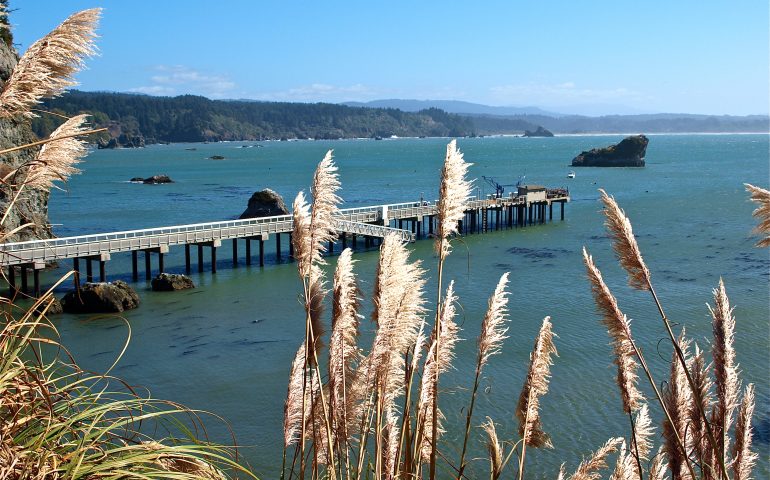Private Pier — Fishing License Required
My first visit to the Trinidad Pier was in August of 1976 and I was immediately struck by two thoughts. The first concerned the beautiful surroundings, both the harbor area itself and the view looking down the coast. The second was the somewhat unique environment of the pier, which contained rocks and kelp all along the inner portion of the pier. I was positive that this would prove to be an excellent fishing pier! Then, within just a few minutes, I hooked and landed a decent-sized kelp greenling and the fish seemed to confirm and make buoyant my expectations.
It turned out that the hope was rose-colored; two and a half hours of fishing produced nary another bite or fish. It would prove to be an inauspicious start to my time at the pier.
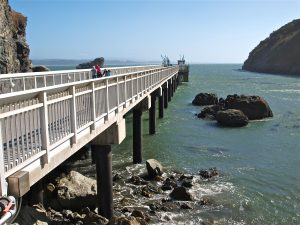
Since then I have made many trips to the pier and have had some really, really good visits. At the same time my records show four visits with no fish at all as well as a couple of others when I caught just a fish or two. Overall my records show only a 3.15 fish per hour average, the lowest for me of all the Northern California piers.
My results match Fish and Game studies done many, many years ago by Daniel Miller and Daniel Gotshall. Those studies reflected pier effort and catches in 1958 and also placed the pier at the bottom of Northern California piers. Given the surroundings, it’s a mystery to this day why the fishing is not better (especially when it is often so good just a short distance offshore in the boats).
The pier is the northernmost oceanfront pier in the state and is also is one of the newest piers in the state following the demolition of an older pier and the construction of a new pier in 2011-2012. The original Trinidad Pier, also called by many the Hallmark Pier or Seascape Pier, was an old, wooden pier that had a charm all its own (especially for dyed-in-the-wool pier rats). But repair and replacement was needed. And, to be truthful, most visitors will probably never know the difference.
Just a short, half hour or so, drive north of Eureka, the pier sees a steady parade of people out onto the pier but few actually seem to pier fish. Most are non-anglers checking out the local pier and its view. If they are anglers they are most often boat anglers arriving for the summer salmon runs or a try at bottom fishing for the rockcod, big lings, and occasional Pacific halibut that inhabit local waters.
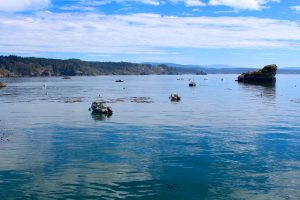
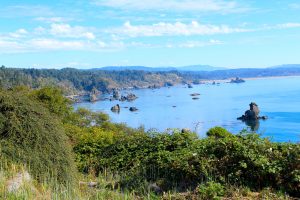
For most people though it’s simply one more place to visit while enjoying the redwood forests and the coast. And that view? There’s still that million dollar, nature lover’s view of the coast extending south of Trinidad. It’s a milieu of emerald Redwood forests reaching down to the waters edge where they meet the cobalt blue Pacific and its rocky shoreline. Throw in a little fog for atmosphere and you’ve got quite a Kodak pleasing picture (you do remember Kodak? Right? Right?).
Environment. The pier is situated in Trinidad Harbor, which means it is protected from the most severe storms by the adjacent Trinidad Head that forms the western border of the harbor. Home at one time to those seeking otter and whale, the harbor today primarily serves as the home base for commercial and recreational fishing. Out toward the end of the 540-foot pier is a ramp leading down to a dock and the skiff rental operation. In addition, there often will be party boats tied to the dock. The boats try to squeeze in several months of good weather fishing, generally June to September.
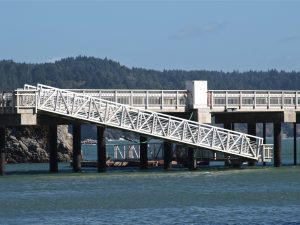
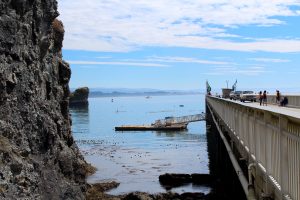
The commercial activities on the pier do lead to some limitations for pier fishermen since the trucks need to unload their supplies out toward the ramp area of the pier. One sign indicates the farthest spot to which anglers are allowed to fish. A second sign proclaims that fishing from the lower area is prohibited. (However, one of my sources says that fishing is permitted from the end and the lower deck when the activities have ceased for the day. Ask at the bait shop for permission.) The lower area is, by the way, disassembled during the winter months to prevent damage from the winter storms.
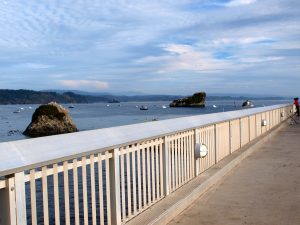
Although the bottom of the bay itself is primarily sand, the area on the east side of the pier presents an almost total rocky environment while the west side of the pier presents a mix of rocks (inshore) and sand (mid-pier to the end).
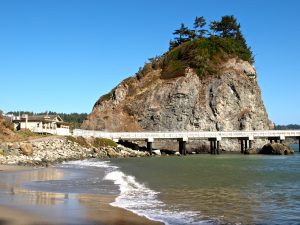
To the left of the pier (east side) is Little Head Rock, a rocky knoll that reaches 125 in height. Sitting a short distance from the pier, it effectively makes fishing a close-in activity with shallow and mid-depth areas along much of this side. Here is where the best fishing is often found.
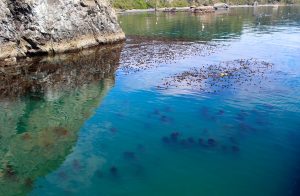
Around the rocks are more than fifty different species of algae, a variety of invertebrates, and various channels between the rocks that fish seem to love. These are the normal attributes of rock fishing and that, in essence, is what you are doing. Think of rock fishing but being able to use a light outfit to do it and, if you’re careful, being able to avoid losing that tackle. However, paramount in this fishing is holding your rod and learning to differentiate between the enveloping pull of kelp, a grab from a crab, and the bite from a fish.
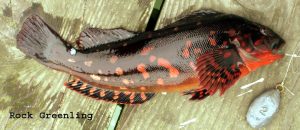
Fish. The rocky area almost always contains some kelp greenling and rock greenling as well as the big cousins of their Family Hexagrammidae—the feisty lingcods. The rockies seem to prefer the shallower water, kelpies are found in both the shallower and deeper waters, and the lings prefer the deeper waters on the pier. Nevertheless, you may catch any of the three species anywhere around the pier.
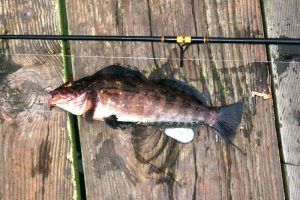
Kelp greenling — (Photo courtesy of DSRTEGl)
Cabezon are also plentiful while a number of rockfish join in the fun. Most common are black rockfish and grass rockfish, but a few blue rockfish, copper rockfish and black and yellow rockfish (supposedly only found north to Eureka) will also enter the bags. Eels, both monkeyface eels and wolf eels are occasionally taken.
Summer months can also see invasions of juvenile, too-little-to-keep rockfish (black, yellowtail, copper, bocaccio) hiding down around the kelp by the pier; be sure to return them to the water if hooked.
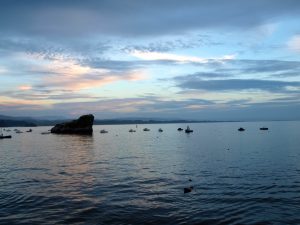
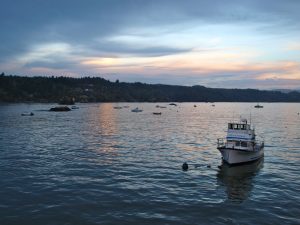
Inshore on the bay or west side of the pier are two large rocks that sit just a short distance out from Pier Beach and are adjacent to the pier. This is where I have caught many, many kelp greenling. Again, the fish will be down amongst the crevices and channels as well as under ledges invisible from above. Move your bait as close to the rocks as possible and be prepared to see fish emerge from under the rocks. Also be prepared to lose some tackle to the rocks and kelp.
The west side (further out) presents a sandy bottom bay for a venue and it’s here you’ll encounter (no surprise) most of the sandy-shore species. More likely to be seen are white seaperch, walleye surfperch, silver surfperch, redtail surfperch, calico surfperch, jacksmelt, Pacific herring (in the winter), sanddabs, starry flounder, sand sole, English sole, Pacific tomcod, white croaker, and perhaps a few rays and sharks. The most common sharay is the big skate and some do indeed get pretty good size (see below). I have heard reports of a few leopard sharks being taken as well as a story on one lone salmon shark. The latter, a fish a little over six foot in length, was carefully wrestled away from the rocks and landed in the surf area. During warm water years, Pacific mackerel may also make a visit.
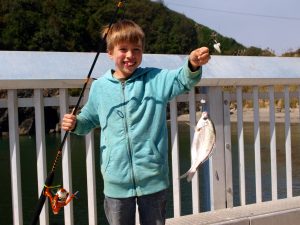
White Seaperch
Straight down, or under the pier by the pilings, can yield several species of fish, including perch and rockfish. However, the numbers are less than to be expected. Surprisingly, the area under the pier is not rich in sea life. Large boulders with very little life on them are present on the bottom while the pilings themselves are not encrusted with barnacles or mussels. It’s postulated that the constant sand scouring of the piling area prevents a good growth of those species.
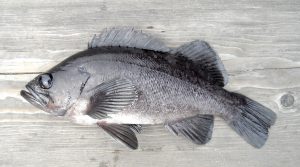
Black Rockfish
Summer months are the exception concerning the piling area. Typically those months have seen good numbers of juvenile rockfish hanging out down around the pilings (where they provide forage for the river otters among others). Given the reduction in the number of pilings in the new pier there is some concern that the number of these fish will be reduced.
When you can fish the end section you are closer to deep water and closer to a hard bottom covered with algae, corals, kelp and sea stars (aka starfish). This is the best section to catch lingcod (especially in the fall and winter) as well as larger rockfish and big cabezon.
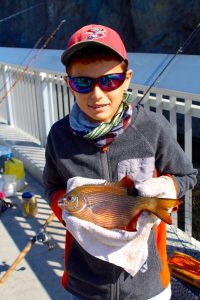
Striped seaperch taken by David Shigematsu
The area by the floating docks can also be good. There is more bottom growth in this area—and more fish. The only problem I have noted is that there are sometimes way too many shinerperch (although those perch can be utilized as live bait for the larger rockfish and lingcod).
Although few people seem to crab here, quite a few rock crabs are available much of the year. Just be careful to toss the crab pot in a sandy area instead of by the rocks.
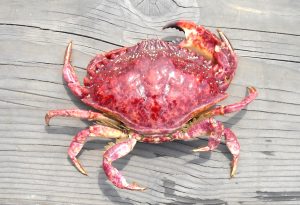
Fishing Tips. If you want rocky shore species, fish on the left side of the pier using tube worms, fresh mussels, shrimp, or crab backs for bait. Use small, size 4-6 hooks attached directly to your line above a half-ounce to one-ounce sinker. Using a light outfit you should be able to feel your bait and keep it out of the rocks. Cast your line as close to the rocks as possible; greenling and rockfish hide under the rock and in rock crevices. As wave action sweeps your bait close to the rocks interested fish will rush out and grab it. Be prepared! Most greenling and rockfish will head straight back to their hole under the rock as soon as they grab the bait. If you let them reach their holes, you will probably lose your leader and sinker!
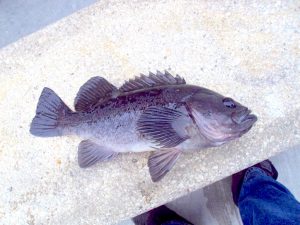
Blue Rockfish
The biggest mistake made by rock anglers is using baits and hooks that are too big for most fish. Generally, the chances of hooking a large lingcod or cabezon are, with a couple of exceptions, fairly remote and many of the other fish, including perch and greenling, have fairly small mouths. Unless you’re really in pursuit of the larger fish, you might want to try for the specimens that make up ninety percent of the fish caught here: kelp greenling, rock greenling, striped seaperch, walleye and silver surfperch, black or copper rockfish, buffalo sculpin, brown Irish lord, and the smaller cabezon and lingcod.
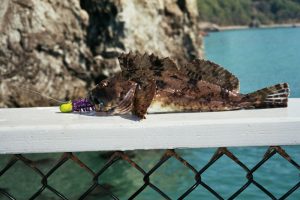
Cabezon — (Photo courtesy of DSRTEGl)
The exceptions to which I referred above are two. The first is the success shown here by anglers using artificial lures such as Scampis and swim baits (Fish Traps, Big Hammer, etc.). There seems to be a good shot at bigger-sized rockfish, especially black rockfish, and lingcod from mid-pier to the end. The key for these fish, especially the predator and ambush loving lingcod is movement, the simulation of a live fish—and live fish move around. Soaking bait in one spot isn’t nearly as effective.
The second exception is during the late fall to winter months, from about September until December. Lingcod come into shallower water to spawn during those months and it is fairly common to see some large lings (20+ pounds) swimming around the pier. Best bait for these big, mean, mama lings is a live shiner or other small fish fished under a float. Shiners can usually be found near the loading dock but if unavailable, try a whole squid or octopus. Be sure to use a heavier line, a medium to heavy rod, and a good net. It is never easy to land a large fish on a pier and especially not one of these nasty lings. They have a habit of appearing to be finished and then showing a second wind just as you are about to net them. So, be prepared!
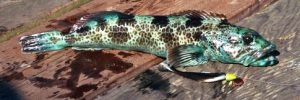
Lingcod — (Photo courtesy of DSRTEGl)
Tyler Epting, a PFIC regular who fished the pier extensively while attending Humboldt State College commented: “Our favorite method for teasing the big lings was to use a bobber with about 6-8’ of leader and a perch or other small fish for bait. It was the only way to fish that area without getting snagged on every cast. My buddy caught a 45” (25-ish lbs.) ling from the lower dock using that method, and I caught many up to about 12 lbs.“
